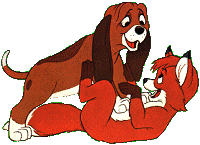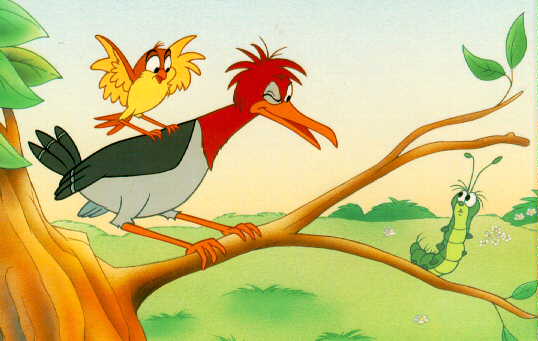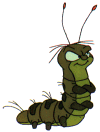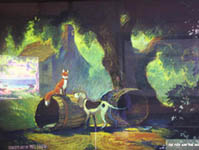

Directed by: Ted Berman & Richard Rich
Written by: Ted Berman & Larry Clemmons
Music by: Stan Fidel, Richard Johnston, Jeffrey Patch, Jim Stafford
 Released
on: July 10, 1981
Released
on: July 10, 1981
Running Time: 83 minutes
Box-Office: $37 million in the U.S.
 Young
Tod... Keith Mitchell
Young
Tod... Keith Mitchell
Older Tod... Mickey Rooney
Young Copper... Corey Feldman
Older Copper... Kurt Russell
Big Mama... Pearl Balley
Grumpy Badger... John McIntire
Amos Slade... Jack Albertson
Vixey... Sandy Duncan
Dinky... Dick Bakalyan
Boomer... Paul Winchell
Chief... Pat Buttram
Widow Tweed... Jeanette Nolan
![]() Mickey Rooney (b. 1920), of his real name Joe Yule Jr., started his career
as a famous child actor alongside the likes of Elizabeth Taylor. He also
starred in Pete's Dragon (1977) as Lampie, and was the voice of
Flip in Little Nemo: Adventures in Slumberland (1992).
Mickey Rooney (b. 1920), of his real name Joe Yule Jr., started his career
as a famous child actor alongside the likes of Elizabeth Taylor. He also
starred in Pete's Dragon (1977) as Lampie, and was the voice of
Flip in Little Nemo: Adventures in Slumberland (1992).

![]() Kurt Russell (b. 1951) landed a part in the Elvis movie, It Happened
at the World's Fair, when he was 10 years old. In 1960, Walt Disney
himself signed Russell to a 10 year contract. Once his stint as a child
actor ended, Russell spent the early 1970's playing minor league baseball.
In 1979, he gave a classic performance as Elvis Presley in John Carpenter's
ABC-TV movie. He followed with roles in a string of well-received films,
including The Thing and Silkwood. In 1983, he met Goldie
Hawn when they worked together on Swing Shift. The two have lived
together ever since. During the 1980's, Russell starred in a rash of disappointments.
Finally, his career seemed to be seriously stalled. He only landed Tango
and Cash after Patrick Swayze dropped out; Dennis Quaid was the first
choice for the part in Backdraft. In the end, these two roles, followed
by the successful sci-fi movie Stargate, were key in re-establishing
him as a box-office draw.
Kurt Russell (b. 1951) landed a part in the Elvis movie, It Happened
at the World's Fair, when he was 10 years old. In 1960, Walt Disney
himself signed Russell to a 10 year contract. Once his stint as a child
actor ended, Russell spent the early 1970's playing minor league baseball.
In 1979, he gave a classic performance as Elvis Presley in John Carpenter's
ABC-TV movie. He followed with roles in a string of well-received films,
including The Thing and Silkwood. In 1983, he met Goldie
Hawn when they worked together on Swing Shift. The two have lived
together ever since. During the 1980's, Russell starred in a rash of disappointments.
Finally, his career seemed to be seriously stalled. He only landed Tango
and Cash after Patrick Swayze dropped out; Dennis Quaid was the first
choice for the part in Backdraft. In the end, these two roles, followed
by the successful sci-fi movie Stargate, were key in re-establishing
him as a box-office draw.
![]() John McIntire (1907-1991) played Sheriff Chambers in Alfred Hitchcock's
Psycho
(1960), and Rufus in The Rescuers
(1977).
John McIntire (1907-1991) played Sheriff Chambers in Alfred Hitchcock's
Psycho
(1960), and Rufus in The Rescuers
(1977).


![]() You might have noticed that Disney's count of their full-length animated
films does not add up to this site's. The Fox and the Hound
gives the answer: it was at one time stated by Disney publicist to be the
20th, but was finally promoted as the 25th Disney full-length animated
film! Partly live action flicks -like The Three Caballeros
(1945)- or compilations of short stories -like The
Many Adventures of Winnie the Pooh (1977)- were added to the list,
building up to a more impressive -but ever since inaccurate- total.
You might have noticed that Disney's count of their full-length animated
films does not add up to this site's. The Fox and the Hound
gives the answer: it was at one time stated by Disney publicist to be the
20th, but was finally promoted as the 25th Disney full-length animated
film! Partly live action flicks -like The Three Caballeros
(1945)- or compilations of short stories -like The
Many Adventures of Winnie the Pooh (1977)- were added to the list,
building up to a more impressive -but ever since inaccurate- total.
![]() This was the first
major effort by the "new generation" of Disney artists. Despite important
contributions from studio veterans, especially at the planning stage, The
Fox and the Hound was carried out largely by younger artists, some
of whom would be key figures in the Disney renaissance of the eighties
and nineties. Among the most gifted of the newcomers was Glen Keane,
who animated the bear in a memorable fight sequence that become one of
the highlights of the movie.
This was the first
major effort by the "new generation" of Disney artists. Despite important
contributions from studio veterans, especially at the planning stage, The
Fox and the Hound was carried out largely by younger artists, some
of whom would be key figures in the Disney renaissance of the eighties
and nineties. Among the most gifted of the newcomers was Glen Keane,
who animated the bear in a memorable fight sequence that become one of
the highlights of the movie.
![]() Don Bluth and
an animation crew including Gary Goldman, John, Lorna Pomeroy (Cooke),
Linda Miller, Emily Jiuliano and Heidi Guedel, left Disney during the production
of the movie, on September 13th, 1979. They had been working on that movie
for about 10 months, and produced about 1000 feet of animation, collectively
(about 11 minute of the movie) -Don and Gary were working on the opening
with the old woman, milking the cow and the intro of the little pups (the
fox and the hound). When Disney Productions finished the feature, they
called the Don Bluth Studios and asked if they wanted credit for the work
his team performed. Don "asked the crew and they all declined. This is
why you do not see any of our names on this film."
Don Bluth and
an animation crew including Gary Goldman, John, Lorna Pomeroy (Cooke),
Linda Miller, Emily Jiuliano and Heidi Guedel, left Disney during the production
of the movie, on September 13th, 1979. They had been working on that movie
for about 10 months, and produced about 1000 feet of animation, collectively
(about 11 minute of the movie) -Don and Gary were working on the opening
with the old woman, milking the cow and the intro of the little pups (the
fox and the hound). When Disney Productions finished the feature, they
called the Don Bluth Studios and asked if they wanted credit for the work
his team performed. Don "asked the crew and they all declined. This is
why you do not see any of our names on this film."
![]() The movie was
delayed in production because of Don Bluth's team leaving. Many decisions
were made that softened the production, one of which involved killing off
the hunting dog, Chief. In the original version Chief is hit by the train
and falls to his death, giving Copper real motivation in getting revenge
with Tod. And it was animated that way! The fall is still there, but animation
was added, having Chiefs eyes open a little as Copper nudges him, implying
that he was hurt but not dead. Of course Chief appears in the rest of the
film and the rest is history, but one wonders what the film would have
been like if they really did kill off 'ol Chief.
The movie was
delayed in production because of Don Bluth's team leaving. Many decisions
were made that softened the production, one of which involved killing off
the hunting dog, Chief. In the original version Chief is hit by the train
and falls to his death, giving Copper real motivation in getting revenge
with Tod. And it was animated that way! The fall is still there, but animation
was added, having Chiefs eyes open a little as Copper nudges him, implying
that he was hurt but not dead. Of course Chief appears in the rest of the
film and the rest is history, but one wonders what the film would have
been like if they really did kill off 'ol Chief.
![]() Another problem
happened toward the tail end of production. A few weeks before release,
someone noticed that some of the waterfalls in the picture were only still
paintings and not animated! In a hurry, effects added spots of light cascading
down the waterfall, but if you look closer, the water is still a painting!
Another problem
happened toward the tail end of production. A few weeks before release,
someone noticed that some of the waterfalls in the picture were only still
paintings and not animated! In a hurry, effects added spots of light cascading
down the waterfall, but if you look closer, the water is still a painting!
![]() At the end of
The
Fox and the Hound, after Copper protects Todd from Amos's gun, you
see Copper walking away from the water's edge. One of his footprints appears
before his foot is put on the ground.
At the end of
The
Fox and the Hound, after Copper protects Todd from Amos's gun, you
see Copper walking away from the water's edge. One of his footprints appears
before his foot is put on the ground.
In searching for animated projects for the studio, veteran animation
producer-director Wolfgang Reitherman came across a book by Daniel P. Mannix
that dealt with the adventures of a domesticated fox. He was intrigued
and excited by the possibilities and remembered that his son had once brought
home a fox cub as his pet.

Production on the movie began in the spring of 1977. Veteran animators
Frank Thomas and Ollie Johnston set the style and pace for the lead characters
with their early experimental tests and actual animated scenes. The two
elder statesmen of Disney animation officially retired from the studio
midway into the production to write the definitive tome on their craft
(Disney Animation: The Illusion of Life, published in 1981). Thomas
and Johnston expanded on their experiences and discoveries at the studio
in two other collaborations, Too Funny For Words (1987), an illustrative
analysis of the cartoon sight gag, and a third book detailing the making
of Bambi.
Additional inspiration for the film was derived from the story sketches and evocative pastel drawings of long-time Disney artist/storyman Melvin Shaw, who also served as creative consultant to the producers. Shaw was part of a team of seasoned storymen who painstakingly adapted Mannix`s book onto storyboards with visual renderings and lines of dialogue corresponding to each scene of the film.
The majority of the animation in The Fox and the Hound was done by a talented group of young artists who were part of a massive recruitment and training program undertaken by the studio in the early 1970`s. Talented individuals from across the country and around the world were sought and hired on the basis of their artistic and creative skills. At the studio classes were held to teach anatomy, acting, cinematography, staging, lighting story, life drawing and the unique entertainment philosophy behind Disney character animation and the feature films. Veteran Disney animator Eric Larson (another of the legendary "nine old men") played an important role in finding and molding this new talent.
 The
new generation of animators, under the guidance of the Disney veterans,
rose to the occasion and created a first rate artistic achievement. Characters
sprang to life in a believable and entertaining manner, involving moviegoers
in the way that Disney animation has traditionally done since its inception.
The
new generation of animators, under the guidance of the Disney veterans,
rose to the occasion and created a first rate artistic achievement. Characters
sprang to life in a believable and entertaining manner, involving moviegoers
in the way that Disney animation has traditionally done since its inception.
In order to recreate natural realistic movements for the animated animals, the young animators studied countless hours of nature films including the Disney True-Adventure films and reference footage shot specifically for Bambi.
The film`s gripping finale, in which Tod bravely and selflessly confronts a ferocious bear provided some of the best and most powerful animation of recent time. It marked the emergence of one of the studio`s top young animators, Glen Keane, who went onto design most of the characters in the 1986 animated feature The Great Mouse Detective. Keane is currently serving as a directing animator on Oliver & Company.
Enhancing the overall look of The Fox and the Hound were the
efforts of the effects animators who provided a variety of realistic natural
elements from water to fire throughout the proceedings. Rich colorful backgrounds
made the naturalistic settings come vividly to life.
|
||||||||||||